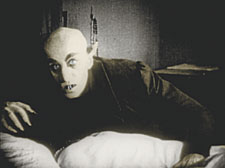|
|
 |
| |

Count Orloc, from Murnau’s Nosferatu |
Golden days of the silver screen
From Nosferatu to The Blood of a Poet, the British Library revisits the cinematic avant-garde
BANKRUPTCY and public rancour were all in a day’s work for the avant-garde filmmakers of the early 20th century, yet without their audacity, argues cinephile Michael Pierce, modern cinema would be a poorer place.
Not content with encompassing design, photography, literature, theatre, architecture and music in their ongoing Breaking the Rules exhibition, the British Library turns its attentions to cinema this month.
Many of the films featured, from FW Murnau’s German Expressionist 1920 horror masterpiece Nosferatu to Jean Cocteau’s shaky 1930 debut The Blood of a Poet, provoked unfavourable responses, even ridicule, on their initial release – now they are looked on as archetypes.
Mr Pierce, events assistant for Curzon Cinemas, picked the films in the exhibition.
“At the time these filmmakers were truly groundbreaking. They developed new techniques of cinematography and narrative that we now take for granted,” he said.
The season begins at the Renoir Cinema, Bloomsbury, with the blood-curdling classic Nosferatu: A Symphony of Horror.
Often considered the original vampire film, it was not original enough for its producers: they were sued for intellectual copyright infringement by the estate of Bram Stoker, author of the 1897 novel Dracula, and for years the film, like its hero Count Orloc, did not see the light of day.
Now its groundbreaking, low-angled camera shots and stop-motion photography can be viewed in a fully restored new form.
Surrealist collaboration Dreams That Money Can Buy (1947) pits the formidable imaginations of Man Ray, Marcel Duchamp and Max Ernst against one another, while New Babylon (1927) features an experimental Shostakovich score, penned in just two weeks, that was scraped by producers in a desperate bid to turn a turkey into a golden goose. It didn’t work but the long-forgotten film and its score now live again.
Mr Pierce said: “Nosferatu still has the power to terrify, whilst the visual effects of Dreams That Money Can Buy and The Blood of a Poet are more dazzling than the lacklustre, overblown CGI common to most modern fantasy films.
“Now, more than ever, in a world of endless sequels and derivative product, it is important to see how experimental the filmmakers were in the early half of the 20th century, where there were no rules or formula on how to make a film.”
The Curzon screenings – part of the Breaking the Rules: The Printed Face of the European Avant Garde 1900-1937 exhibition at the British Library – begin with Nosferatu: A Symphony of Horror at the Renoir, Russell Square on January 20, 12 noon. Tickets £6.50. Visit: www.bl.uk/breakingtherules |
 |
| |
|
|
|
 |
|


